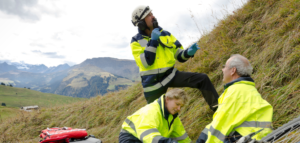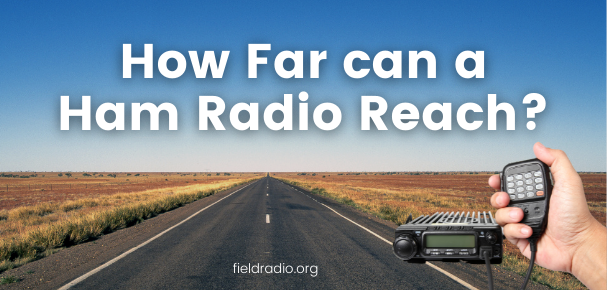Knowing emergency frequencies for Ham radio is as critical as having the radio.
That’s right.
Most people think their bug-out bags or emergency preparations are complete the moment they buy a handy dandy Ham radio.
However, unless the radio is programmed to receive the right Ham radio frequencies, it is pretty much useless.
Therefore, you must know at least basic emergency frequencies so you can continue to receive critical information and transmit messages, even if the entire communication infrastructure is down.
In this article, I will be sharing basic emergency Ham radio frequencies, so you know which way to dial in distress. Also, if you read till the end, you will find the answer to whether you can make an unlicensed SOS call on Ham radio, along with important amateur frequencies that may save your life one day.
How Does Ham Radio Help In Emergencies?
Ham radios don’t rely on conventional communication infrastructures and are, therefore, a reliable communication resource for emergencies.
Ham radio operators or Hams help disparate government organizations to come together and enhance interoperability in disasters. They help family members in calamity-struck areas to inform their loved ones of their safety. Moreover, these devices enable people to call for help and receive critical information when nothing else seems to work.
Ham radios have played a critical role in numerous national disasters. Whether it is the rescue and relief operations after Hurricane Katrina or communications during the deadly 9/11 attacks, these devices have served the public in more ways than one.

What Ham Radio Frequency Will You Use In An Emergency?
You must program all the emergency frequencies for Ham radio beforehand, so you don’t have to scramble for them in the face of a disaster.
Below are some of the most important emergency frequencies that you absolutely must have in your emergency-response Ham radio:
The Local Ham Radio Frequencies
Your local Hams communicate over the local Ham radio frequencies. Knowing these frequencies, you can chat with the local radio operators and enthusiasts and connect with them in face of disasters.
You can find these frequencies simply by reaching out to your local Hams, going to the local Ham Clubs (believe me, they exist) and by participating in Ham radio activities and drills.
You also need to find out and tune in the frequencies of your local repeaters. This is important in case there are no Hams nearby when the calamity arrives, and you have to communicate with Hams in far-off areas.
You can find your local repeaters’ frequencies and offset on databases like repeaterbook.com.
The National Ham Radio Frequencies
The national simplex frequency is a good starting point for new Hams and is often monitored regularly by other Ham users. Therefore, transmitting a distress call on these frequencies is more likely to get a response.
The simplex frequency for the 2m and the 70 cm bands are 146.520 MHz and 446.00 MHz, respectively. Be sure to keep these frequencies in mind and key them in when you cannot think of anything else.
Apart from national simplex frequencies, there are other national frequencies that you should tune your radio to so that you can continue to receive critical information, even during a communication blackout.
The NOAA Broadcasting
The National Oceanic and Atmospheric Administration or NOAA works with the FCC to broadcast live weather updates 24/7. This is the single most comprehensive source of information for weather-related emergencies, so you want to monitor their frequencies.
The NOAA broadcasts over seven different frequencies between 162.400 and 162.550. Programming your device to any one of the following frequencies should be enough for you to monitor the situation and receive life-saving information:
- 162.4
- 162.425
- 162.45
- 162.475
- 162.50
- 162.525
- 162.55.
FEMA Broadcasts
The Federal Emergency Management Association, FEMA provides humanitarian aid in times of distress.
The FEMA reportedly broadcasts over the VHF range of 138.225 to 409.1250. You can get crucial food, health, shelter, and other relevant information by programming your radio to receive signals through one of their many frequencies.
Other Ham Radio Emergency Frequencies
Apart from FEMA and NOAA, there are different frequencies monitored and used by various organizations to offer aid during emergencies. Some of these are:
- 34.90 for Nationwide National Guards
- 39.460 for police forces’ inter-department emergency communications.
- 47.42 for National Red Cross relief operations.
- 121.50 for International Aeronautical Emergency.
- 154.280, 154.265, and 154.295 for Fire Department’s inter-department communications.
- 155.160 for search and rescue information and emergencies.
- 163.4875 for National Guard Emergency
- 164.500 for monitoring communications within the Department of Housing and Urban Development.
There are numerous other amateur frequencies for emergencies. But you can stay safe, connected, and informed by programming at least these frequencies in your radio.
The Ham Radio Emergency Channel
If you have come across emergency frequencies just now and a disaster strikes before you get the time to tune your radio to them, fret not.
Just remember the VHF Channel 16 operates on a globally accepted international distress frequency of 156.800 MHz. And if you have no idea which frequency to monitor or transmit a distress call to, keying this one in can help.
This frequency is monitored by US Coast Guards and Maritime 24/7 and can get you the help you need when nothing else is available.
Can I Use a Ham Radio Without A License in Emergency?
Ah, the controversial question.
Whether or not to use a Ham radio for emergency transmissions is the grey area of the Hams’ circle.
You can use the Ham Radio for receiving signals and listening to broadcasts without a license, even when there is no emergency. However, unlicensed use of the device for transmissions is where things get confusing.
To give you a quick answer: Yes, you can use Ham radio for transmissions WITHOUT a license in an emergency.
But, before you start broadcasting unlicensed distress calls for a flat tire, read the long answer:
Unlicensed use of Ham radio for broadcasting is a serious offense, punishable by hefty fines and, in some cases, even imprisonment.
However, the law makes an exception to this rule if there is an immediate threat to human life and no other communications are available or possible.
This means if you are in a life and death situation and no other communication channel is working; you can (and should) hop on Ham radio frequencies and call for help regardless of whether you have a license or not.
That’s one thing out of the way.
Now, what about receiving calls from unlicensed Hams?
This exception also stands in case a licensed Ham receives a distress call from an unlicensed individual.
That means you can receive a call from and help an unlicensed individual if their life is in danger and they have no other means of communication.
Final Word
Ham radios, though widely operated as a hobby, are critical equipment in times of distress.
You should know all emergency frequencies for Ham radio and program them in your device beforehand to make sure your emergency communication device serves its purpose.
If, for some reason, you cannot do that, just remember to key in 156.800, the global distress frequency, and transmit your distress call. This will most likely get you some help.
As for the license/unlicensed Hams’ dispute, you don’t need to have a license to use ham radio in emergencies involving threats to human life. But this exception is valid only if there are no “conventional” means of communication.
Having said that, it is always better and much recommended to get a Ham Radio License. An authorization from the FCC helps you enter the amateur radio world legitimately and unlocks new doors for you, enabling you to stay safe and serve the general public.

I have been passionate about the world of communications in its various forms for most of my life. Ever since I first found an old ham radio stashed away in my uncle’s attic, I have had a fascination with this classic technology.
Having the ability to communicate with people without the need to rely on telephone lines or networks is an empowering feeling which I believe everyone should have at least a basic knowledge of. Becuase who knows when you might need it?
I setup fieldradio.org with this passion in mind, to help inform people about the amazing possibilities of amateur radio and I’m on a quest to help educate as many budding operators as possible.
I hope you enjoy our content. Come and say hi, via our contact form



